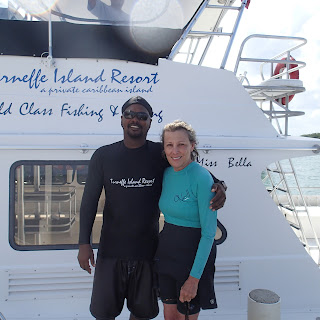Turneffe Island Resort is set on a small caye the size of a few football fields, at the southern end of the world's second largest reef. It's a comfortable, informal group of cottages facing the morning sunrise.
It's popular with scuba divers and fisherman, who go out for permit and bonefish with flyrod. I came here because the snorkel boat goes out twice a day, coffee is delivered to the room every morning, and it's far far away.
Wind energizes and cools, and the palms click as I sat upstairs on my screened porch watching sky and sea. I never felt like I was indoors. The enjoyment of being outdoors and soothed by a warm breeze was almost continuous. A screened outdoor shower was a fine pleasure, listening to birds call.
I am compelled by the existence of islands in vast blue waters. From the air high over the Pacific I have watched as the plane, unerring, gained Hawai'i, Yap, Okinawa, The Philipines, Wake, Guam, Moorea, Bora Bora. Then it aligned with the ribbon of runway that would grant me footfall upon these shelters, so only of the earth and not of the world.
So quickly to be borne up, then step out, a few hours later, in a world so strange and different, so new and beautiful. I felt this in the early years as a flight attendant, the strength of acceleration during take off, and the feeling has never left me.
 |
| French angelfish,intermediate phase |
 |
| Spotted drum - the long fin is curling up as it swims here - it usually looks like a v-shape. |
 |
| Banded butterfly fish |
 |
| French angelfish - a wonderful black and gold fish, elegant and thin, surpassing any bold abstract jewelry design. |
 |
| Blue chromis (about 2") like seeing large fireflies, these dart about the reef, the blue color forever elusive and unachievable on the palette. |
 |
| Dusky?squirrelfish (not elusive as they are in Tahiti) |
 |
| Glasseye snapper - I found this myself |
 |
| Drum or goatfish? - seems to rest on its front fins on the ocean floor |
 |
| Gray angelfish - a complement to the French and queen angels, it's coloring is restrained and rich. |
 |
| Hogfish THE BLUE HOLE
In 2012, Discovery Channel ranked the Great Blue Hole as number one on its list of "The 10 Most Amazing Places on Earth". It's also a part of the larger Belize Barrier Reef Reserve System, a World Heritage Site of the United Nations Educational, Scientific and Cultural Organization (UNESCO).The Blue Hole is 410 feet circular sinkhole limestone formation with underwater stagtites and stalagmites. Around the edge the reef forms a circle about 150 yards across. Jacques Cousteau made it even more famous with a documentary film.
|
I was very surprised that my snorkeling didn't find as many fish as I have seen in other locations. I saw many juveniles, but we saw many more fish in Tahiti and Hawai'i, I think. I suppose the lionfish is the reason, as we saw 4 or 5 of them during 10 snorkel excursions.
 |
| I saw several reef sharks, but at a distance and they quickly swam off when they became aware of us. |
 |
| Rock beauty, adult - another special fish, it is boldly colored. |
 |
| Blue tang school - a dark fish with bright neon blue fin edges that glint with movement and sun |
 |
| Scrawled cowfish - A new fish for me - this guy posed for me- he's about 18" long, and has little horns over his eyes. I found them quite funny, too. |
 |
| Trumpetfish (photo by JV, my snorkel guide) a wonderful skinny fish that sometimes hangs in vegetation vertically to feed and hide |
 |
| Squid - we saw a group of these floating serenely - the spots on their backs are like tiny white-blue LEDs |
 |
| Face, spiny spider crab (photo by JV) - my snorkel jefe, JV, was a Criol ex-commercial diver who found many wonderful creatures hiding while we were reef cruising. He loved my new camera. |
 |
| Spiny spider crab (photo by JV) |
 |
| Spiny lobster - we saw dens of 4 or 5 of these several times, and also saw a slipper lobster. |
 |
| Marbled grouper - this species is reduced on the reefs from overfishing |
 |
| Scorpion fish - can you see his eye and body hidden on the sandy bottom? He looks rather cuddly, despite his prickly body. |
 |
 |
| Sponge? the corals and sponges all suggested abstracted ceramic sculptures from the California ceramics movement led by Peter Voulkos |
 |
| Orange tube coral? Amazing bright orange clump - I cannot discern the projecting tubes however. |
 |
| Pillar coral? - the tips are pale lavender |
 |
| Common sea fan - but their ubiquitousness gives the golden and khaki corals the complement of violet and lavender, and their gentle undulations in the current are beautiful. |
 |
| Staghorn coral |
 |
| Elkhorn coral |
 |
| Southern stingray (photo by JV) a large one, taking his time. We saw these three times, and also an eagle and spotted ray. |

Queen Triggerfish - so common in Tahiti and Hawai'i, this is the only one I saw in Belize.
















































